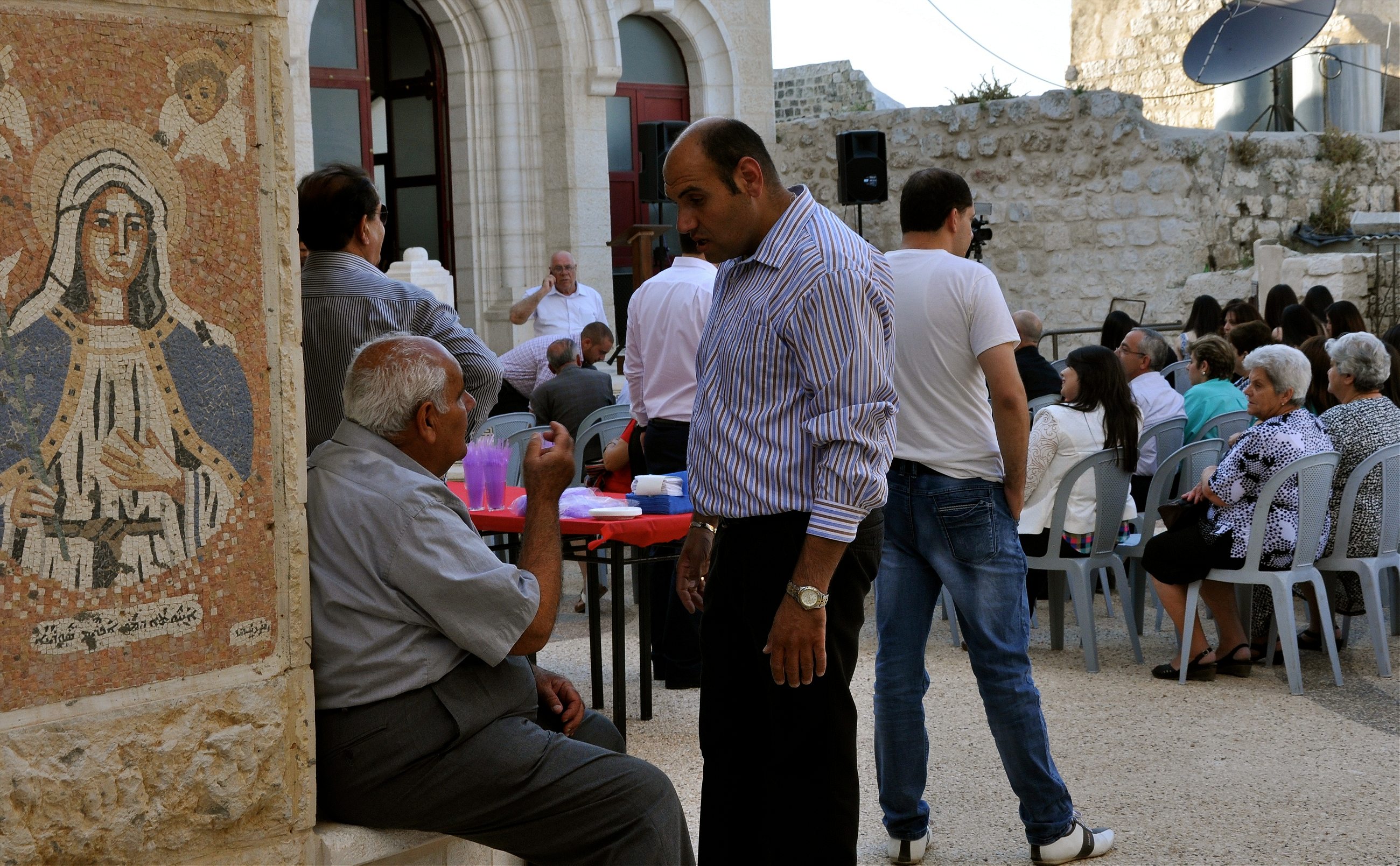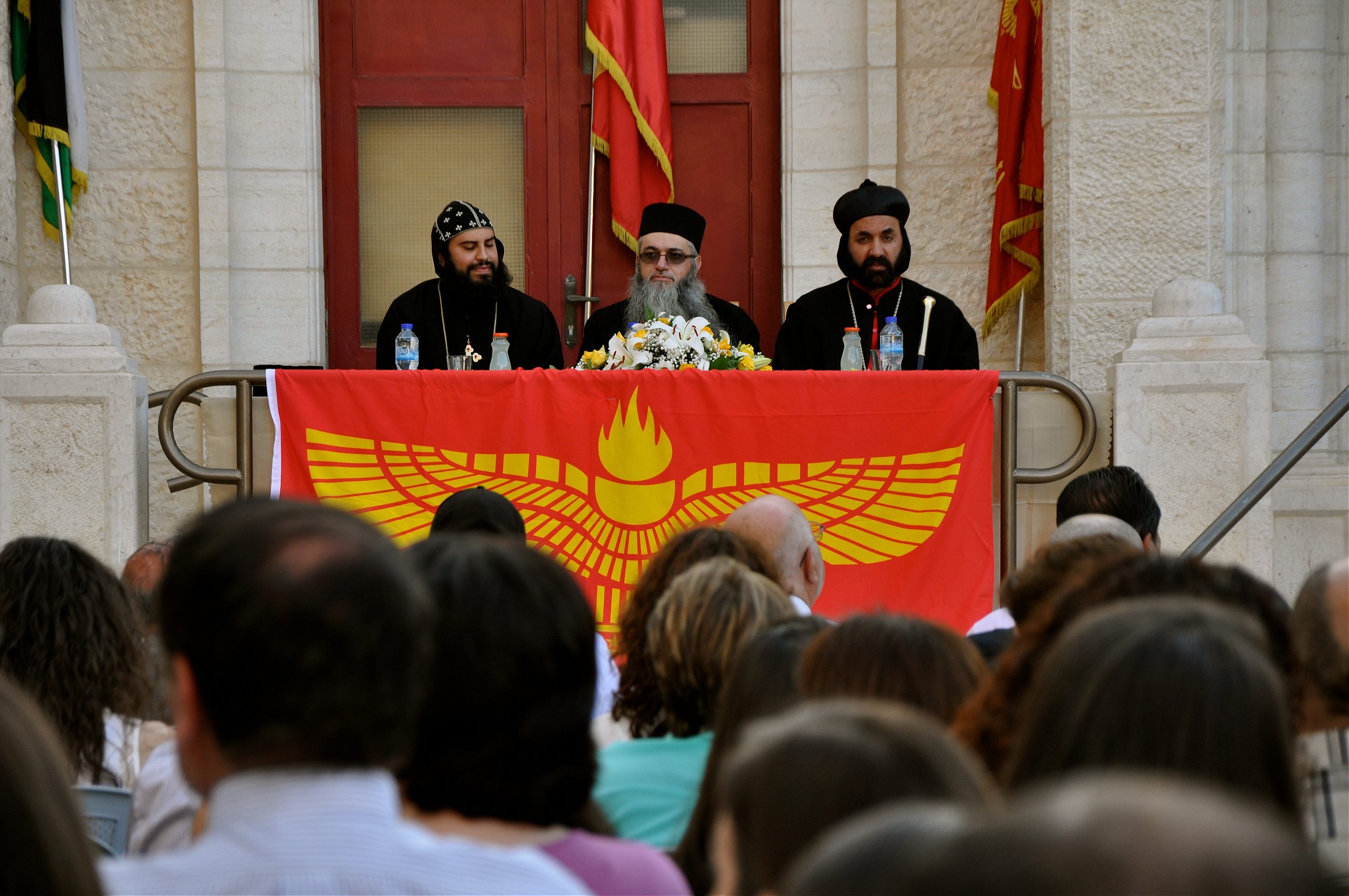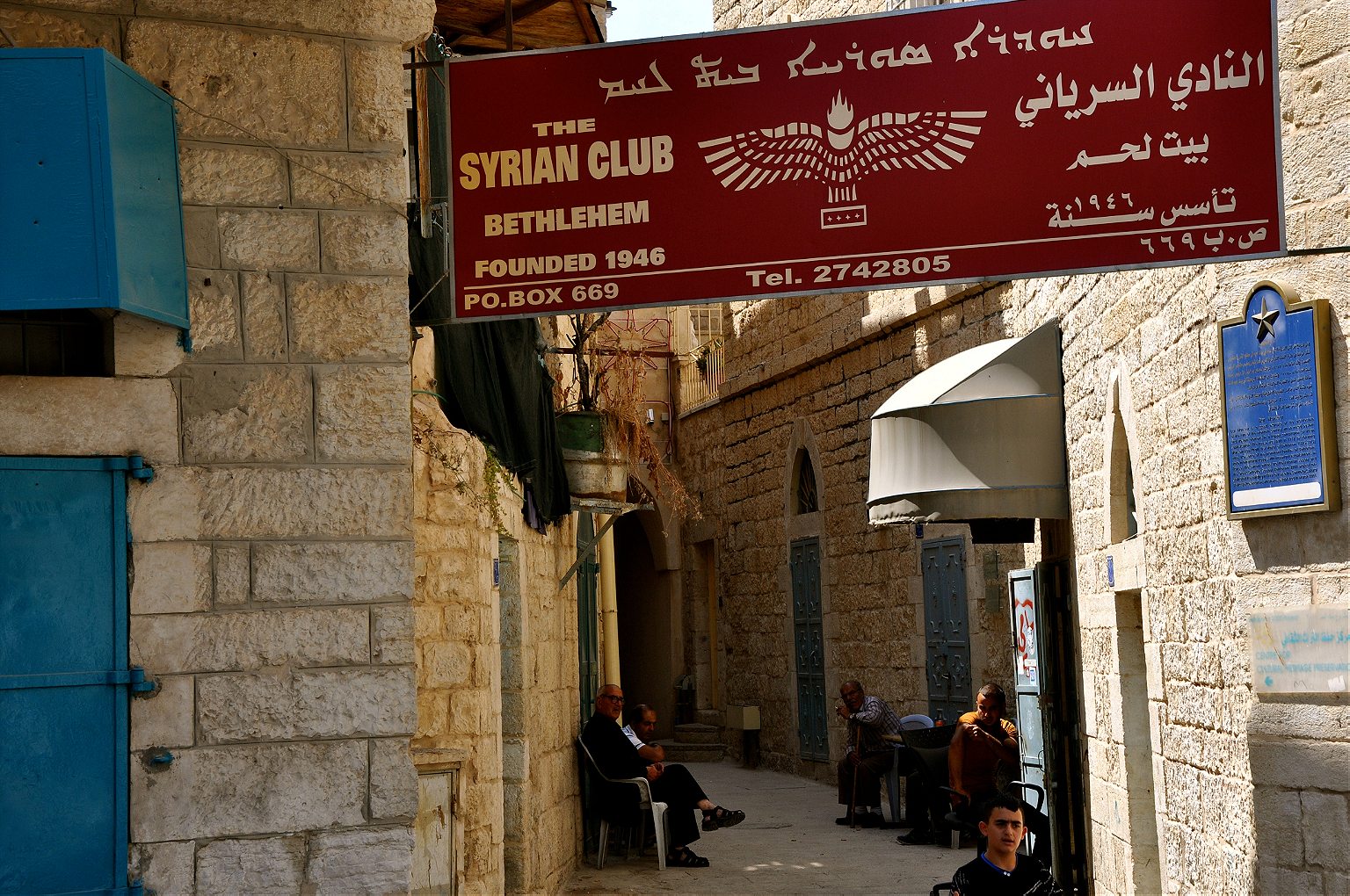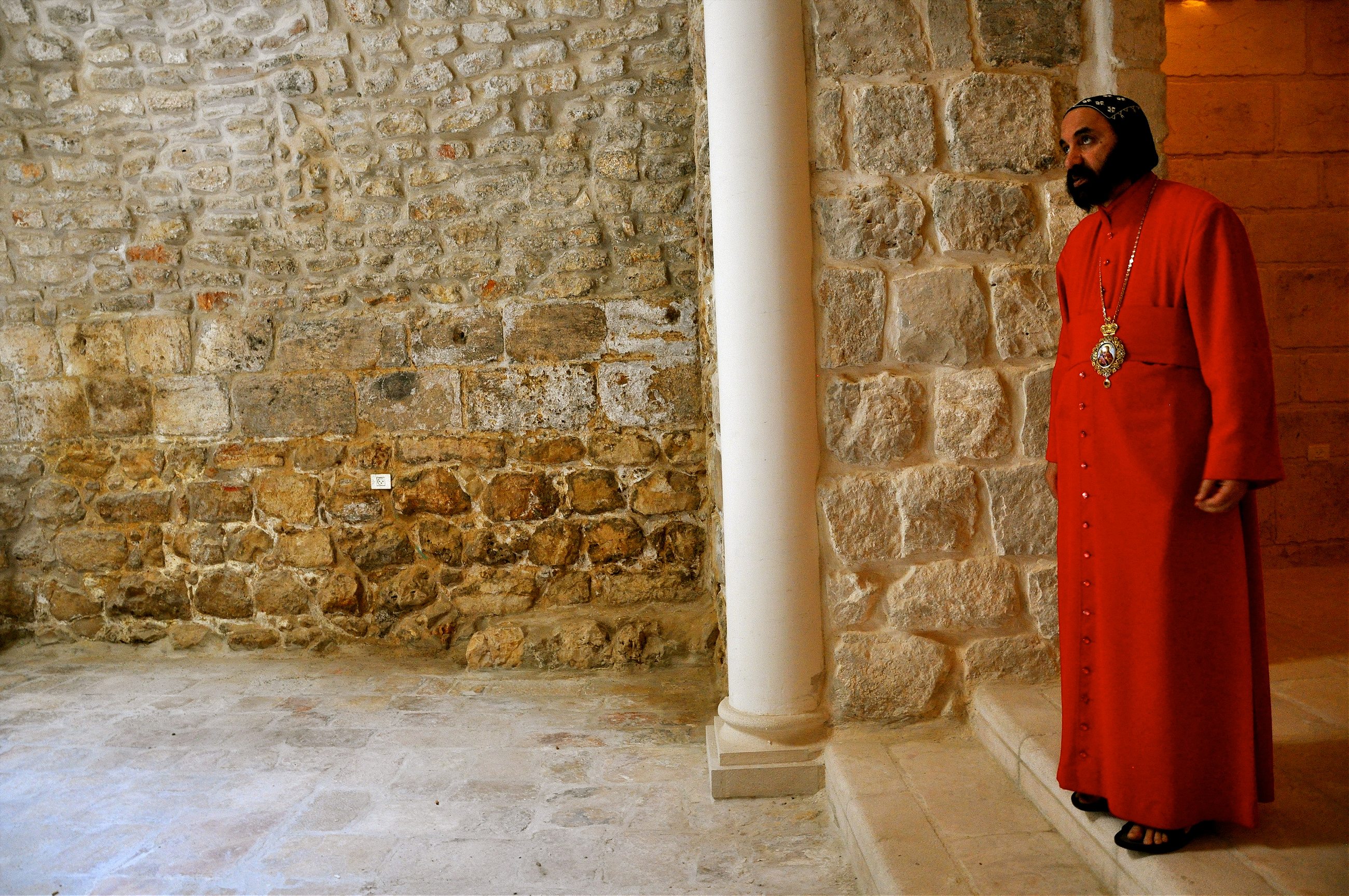The struggling Syriac community is hoping that renewed interest in Aramaic could help their flagging culture endure.
Just a few hundred feet west of the church built atop the site where the Christian faithful believe Jesus was born, the sounds of the ancient tongue of Aramaic echo across glimmering icons and portraits of Biblical scenes adorned with the language’s jagged script. Here, at the Mother of God Church in Bethlehem’s Old City, services are held in the language every Sunday.
The Aramaic used in church is the formal written form considered sacred, not the vernacular language that was once commonly spoken, most famously by Jesus Christ. Throughout the service, Arabic translation is given by Father Butros Nimeh, the first parish priest to have been born and raised in Bethlehem. For the priest, the long-term decline of Aramaic in this small community is an existential threat.
“If we preserve our language, we preserve our history and our existence. Where there is a language, there is a people, a heritage, and a civilization,” he says. “If there is no preservation of this heritage, however, we will be finished as a community.”
Members of the community he refers to are commonly known as Syriacs (or Syriani in Arabic) who trace their roots to an Aramaic-speaking region that once spanned the region where Iraq, Syria, and Turkey today meet. (The name “Syria” is thought to be derived from the word “Assyria,” which also gave its name to the community as well as the closely-related Assyrian community that still lives in northern Iraq). This 5,000-strong Syriac Christian community mostly descended from Syriacs fleeing to Palestine following mass killings in the Ottoman Empire in the late 1910s. Around the same time as the Armenian Genocide, approximately 300,000 members of the Syriac and Assyrian communities perished in what they call the Seyfo, or “Sword” in Aramaic, amid the wider ethnic strife and political chaos that accompanied the slow collapse of the Ottoman Empire. The Syriac homeland in what would become Turkey was devastated, the vast majority killed or forced to flee.

Thousands of Syriacs survived by fleeing to nearby Arab-majority countries, and hundreds made their way to the Holy Land, following routes originally learned through pilgrimage or trade. They found refuge in what would become British-occupied Palestine, and many moved into what became known as the Syriac Quarter. Today, most have moved out of the tiny compound into other neighborhoods of Bethlehem, but the area remains at the heart of community life. Atop a hill just beside the quarter sits the Mother of God Syrian Orthodox Church, the highest in the city, while a social club is located in a cavernous hall in the heart of the area.
Soon after taking up residence as the local priest, Nimeh launched a curriculum at Bethlehem’s Syriac-funded Mar Ephrem School that includes Aramaic classes, a first in community history. For over a decade, under his instruction students have been studying the community’s ancestral tongue, and a new generation of youth enrolled at the school—both Syriac and non-Syriac, Muslim and Christian—are speaking the tongue again.
The word Aramaic originally comes from “Aram,” a historical region in northern Palestine, and it became the official language of administration across the Middle East after the Assyrian Empire conquered the region and deported locals from the area. As a result of the deportation, the language spread far and wide and took root in many far-flung corners of the Empire. It is a point of pride among Syriacs that Aramaic was the lingua franca of the entire Middle East for more than a millennium.
The written language resembles an older, formalistic Arabic script known as Kufi and many letters are deceptively similar in appearance, almost like a cross between Arabic and Hebrew. The relationship actually flows in the opposite direction, however, as the Aramaic alphabet helped birth the Arabic and Hebrew alphabets and the three languages are closely related. The rhythm and sounds of Aramaic strongly resemble Arabic, and while full of cognates easily recognizable by Arabic speakers, the language is somewhat heavier on the “khs” and “shs” in terms of sound. To give an idea of the similarities between the languages, “Our Father who art in Heaven” is rendered “Abouna fi al-Sama” in Arabic and “Aboun da b-Shmaya” in Aramaic.
Although the definitively non-Christian Assyrian Empire originally spread the language across the region, today it is closely associated with the religion given the fact that Jesus spoke a version of it (albeit a completely different dialect). However, despite the central place the language has as a marker of Syriac identity, almost no one in Palestine actually speaks Aramaic. Archbishop Sewerios Malki Murad, the head of the Syrian Orthodox Church in the Holy Land and Jordan, says that today, only perhaps 10 percent of Syriacs in Palestine speak or understand the language. He added that many of the community’s great-grandparents only spoke Arabic as well. The language thus has an almost phantasmic presence in the lives of community members, a potent sign of a historical identity that few can actually parse but all take pride in.
“People are happy to see kids talking and singing in a language that their parents can’t even understand,” Nimeh says.
For Syriacs in Jerusalem and Bethlehem, Palestine has become the primary homeland
So far, the language classes fall far short of a general revival, and no one in the community is expecting Syriacs to drop Arabic for Aramaic as a home language any time soon. But the hope is that the language will take on a more personal dimension for members of the community instead of being restricted to church. The use of language in religious services does not necessarily have strong implications for group identity, just as the continued use of Greek in Greek Orthodox churches around the world does not necessarily tie the faithful to that country, or as the use of Latin in Catholic churches did not necessarily engender affection for the Roman Empire.
But Aramaic is different, given that the community sees itself as an ethno-religious group tied primarily by the history of its language. Unlike their Assyrian/Syriac counterparts in northern Iraq or northeastern Syria, for whom their sense of identity is tied to physical territory where the community predominates, for Syriacs in Jerusalem and Bethlehem, Palestine has become the primary homeland (even if events facing Syriacs elsewhere are closely followed). Although some have returned on visits to see their ancestors’ homes in what is now Turkey, the connection to those villages has been lost in the intervening century. In this context, language preservation is one of the few ways to hold onto the community’s tenuous history. And given the community’s limited funds, the Aramaic classes function as a crucial symbolic start for a community defined by a linguistic heritage that feels far removed from current realities.

“Syriacs are a minority, and even though they are a part of the Palestinian society in which they live, as a minority they fear the loss of their culture and origins,” Nimeh says.
The role of the church in preserving community heritage is crucial for Syriacs, as it is one of the few institutions with a constant presence in their lives to remind them of their distinct history. But while the church may be at the forefront of fighting what it sees as cultural loss, the larger political equation Syriacs find themselves in is a different matter.
The population of Syriacs in Palestine peaked in 1948, but collapsed the same year when the state of Israel was declared on a majority of historic Palestine and 750,000 Palestinians were subsequently expelled from their homes. Hundreds, if not thousands, of Syriacs fled to Jordan or the West in the ensuing chaos. The scene was repeated in 1967, when Israel occupied the West Bank, invading the two places where large Syriac communities lived: Bethlehem and the Old City of Jerusalem.
While Bethlehem’s Syriac Quarter is today a strong symbol of community identity and a physical and geographic reminder of their history and identity, the story of Jerusalem’s Syriac Quarter has been almost entirely erased from memory.

When Israeli forces occupied Jerusalem in 1967, one of their first acts was to build a large plaza in front of the Western Wall by completely flattening the Palestinian Mughrabi Quarter and expelling its 650 inhabitants. Little known is that the Syriacs once had their own quarter as well, squeezed between the Armenian and Jewish Quarters at the Old City’s southern end. In the summer of 1967, as war raged on the frontline cutting through the heart of the city, thousands fled their homes. When quiet returned, hundreds of Syriacs returned to find that their homes had been taken over by Israeli authorities and were scheduled to be handed over to Jewish settlers or else demolished to make way for housing exclusively built for Jews. Almost overnight, Syriacs—who were identified by Israeli authorities as non-Jewish Palestinians and thus subject to systematic expulsion—found themselves refugees yet again.
Joseph Khano, an 89-year-old Syriac born in Bethlehem but who spent most of his life in Jerusalem, tells a story that would be familiar to many Syriacs in the area. As a child, he grew up in the upper-class Arab suburb of Qatamon southwest of Jerusalem’s Old City, but in 1948, Zionist militants seized the area and all of its Arab inhabitants were forced to leave and their properties seized.
Khano’s family fled to the Old City, which was beyond Israeli control, but in 1967, he was forced to flee again. At the time of the invasion, Khano was traveling in Lebanon for work, and when he rushed home as news of war broke out he found that the Israeli soldiers stationed at the newly created border between Jordan and the West Bank refused to let him across.

Like 300,000 other Palestinians—hundreds of Syriacs among them—Khano was barred from returning, part of a second wave of expulsion by Israel. Khano managed to swim across the Jordan River under cover of night and bribe officials to forge him papers that would allow him to stay, but most others were not so lucky. He estimates that 65 percent of the Syriacs left Palestine for good in 1967 or the years since.
Today, only one small alleyway is left of Jerusalem’s Syriac Quarter, on which a Syriac social club and St. Mark’s Monastery—where the Archbishop is based—are located. The area is a sad remnant of its former self, a quiet residential lane stuck between the heavy traffic of the Armenian Quarter to the West—crowded by Armenian-Palestinian locals and Eastern European Christian tourists—and the new-but-made-to-look-old Jewish Quarter to the East, where religious Israeli Jews and Jewish tourists come for spiritual redemption.
Archbishop Murad estimates that only a few Syriac families still live on the street, while a few hundred of the former residents live scattered in Palestinian neighborhoods around East Jerusalem. Since then, Israeli policies imposed on Palestinians—for example, prohibiting new construction and revoking residency if an individual lives outside of the city seven years or longer—have taken their toll on the community.
In Bethlehem, a similar situation reigns. Issa Bassous, 43, owns a small antique shop in the Syriac Quarter, and although he is emphatic that he has never considered emigrating, he says that it’s not hard for him to understand why others do.
“From the moment I entered this Earth and became aware of the world around me, I have been surrounded by problems,” he says. “The First Intifada, the Second Intifada, and so on: we haven’t seen anything else in our lives but problems. Every time things get a little better, the problems begin again and everything goes back to how it was. There is no future here, nor life.”

Bassous noted the effects of the Israeli occupation on Palestinians, limiting their economy and also cutting apart their families. He says that he has cousins in Jerusalem but has never met them, since the city—which is only five miles away—is cut off from Bethlehem by a military checkpoint and he rarely gets a permit to cross.
Back in Jerusalem, Archbishop Murad worries the situation is bad enough that the community in Bethlehem could completely vanish, only 50 years after the destruction of the Syriac Quarter there. “Bethlehem and the West Bank have become like a giant prison,” he says. “There are checkpoints everywhere, every day, all day.”
Despite the instability, the Archbishop is sustained by the conviction that he is doing the Lord’s work. “We’re still happy that we’re here, serving the church here,” he says, “and we will continue to carry out the mission of love and peace that our ancestors laid down for us, the testament of the Bible and the Messiah.” Whether or not that is enough to guarantee the future for the majority of Palestine’s Syriacs remains to be seen.